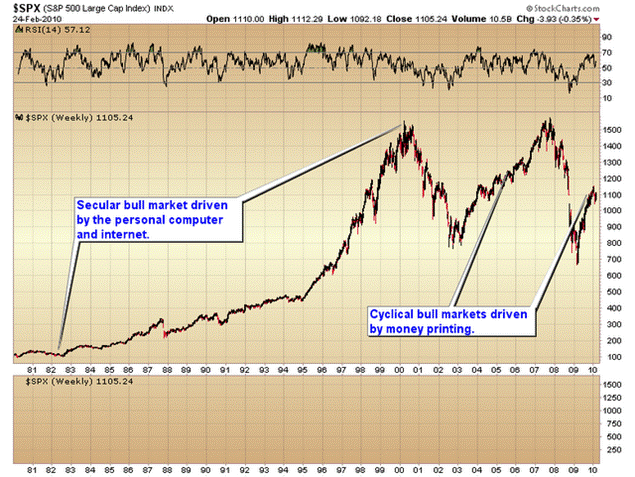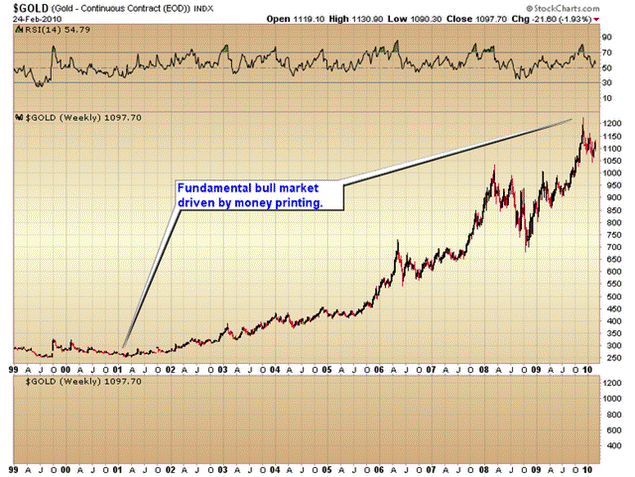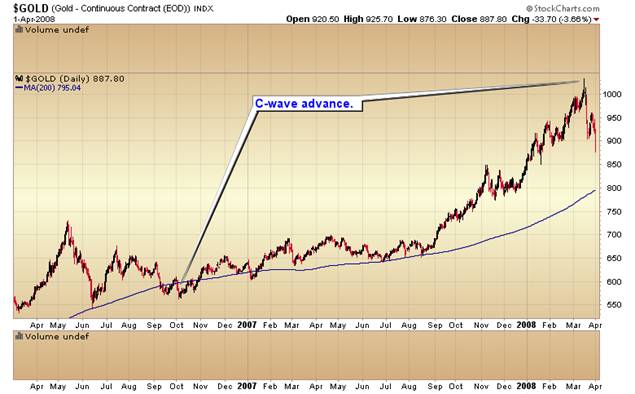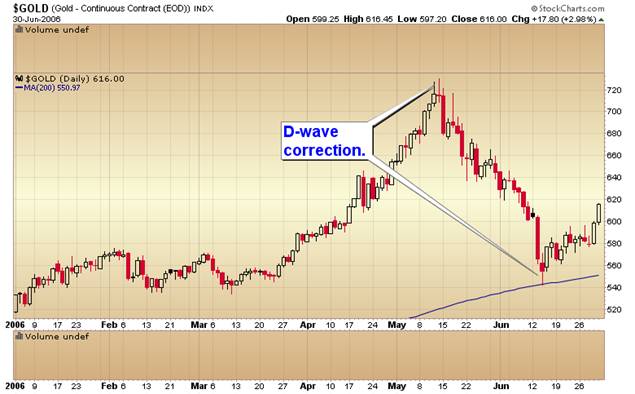Cyclical Stocks Bull Market vs. Secular Gold Bull
Commodities / Gold and Silver 2010 Mar 04, 2010 - 01:18 AM GMTBy: Gary_Savage
 Since March of 2001, the stock market has been and continues to be in a secular bear market. Beginning in March 2009, stocks have been in a cyclical bull market. This means our current stock market is in a relatively short term bull rally within a much longer term secular bear market decline.
Since March of 2001, the stock market has been and continues to be in a secular bear market. Beginning in March 2009, stocks have been in a cyclical bull market. This means our current stock market is in a relatively short term bull rally within a much longer term secular bear market decline.
The current rally will serve to separate the second phase of the secular bear from the third and potentially most damaging leg down in the ongoing bear market.
Now that doesn't mean the rally since March 2009 is finished. I doubt it is.
What it does mean is that one can't make a timing mistake and expect to be rescued by the secular trend.
At some point this bull is going to expire and we are going to head back down and break the SP500 lows at 666, either nominally or on an inflation-adjusted basis. I suspect it will be both.
The reason it’s going to do that is simply because we don’t have a fundamental driver to power a long term bull market in place. For instance, from 1982 to 2000, the stock market was in a secular bull market. The fundamental driver for that bull was the personal computer and the internet. Those were world changing new technologies. Millions and millions of jobs were created during this period.

There were certainly nasty corrections during the secular bull, for which 1987 is an example. But the secular trend was up. So as long as one was willing to hold onto positions, any entry no matter how poorly timed, would eventually end up being a winning trade. (It’s the strategy Buffet used to become a billionaire, by the way).
Simply said, only traders can lose money in a secular bull market. The only way to lose money in this type of market is to buy high and sell low. And, a buy and hold strategy is the only sure fire money maker in a long term bull.
The problem with the stock market since 2000 is that there is no longer a fundamental driver to produce a secular bull. We haven’t discovered the next “big thing” yet. The new technology that will change the world again, drive massive economic growth and create the millions and millions of new jobs the world needs so desperately.
Now all we are getting are phony cyclical bull markets built on money printing. Those are not the kind of fundamentals that can support a sustainable long term bull market.
So what happens? Well, eventually the false fundamentals fail and the market collapses.
The Fed is now at it again trying to build another bull market on a fundamental base of nothing more than trillions of dollars of liquidity (printing money out of thin air). It didn't succeed when Greenspan tried it earlier in the last decade, and it's not going to succeed for Bernanke in this decade.
Until we get the next fundamental driver (i.e. personal computers & internet 1982-2000, electronics 1945-66, automobile and mass production 1920-29, trains in the late 1800's) we are not going to have another secular bull market for stocks.
There is a sector however that does flourish on a fundamental base of money printing. That sector is the commodity sector, in general, and the precious metals, specifically.

Gold is in a secular long term bull market. This means several things. First off, we can expect this bull to continue until the fundamental driver is taken away. That means the money printing presses have to be turned off. Second, any entry will ultimately turn out to be a winning position as long as one is willing to hold on.
Investors would do well to remember that the bull will eventually correct any timing mistakes.
That being said it is possible to maximize gains and minimize draw downs if one can recognize where gold is in its wave cycle at present. As all of the gains occur during a C-wave advance one wants to be fully invested during this period.

Probably more importantly one needs to recognize when the C-wave is coming to an end and exit positions before gold enters the inevitable D-wave correction.

At the moment gold appears to be entering a second leg up in the ongoing C-wave. The trick will be to sell at the top when things look the brightest and then re-invest at the bottom of the D-wave… when things look the bleakest.
I will be monitoring the advance closely over the next couple of months so as to get subscribers out prior to the onset of the next D-wave.
Gary Savage
The Smart Money Tracker
Gary Savage authors the Smart Money Tracker and daily financial newsletter tracking the stock & commodity markets with special emphasis on the precious metals market.
© 2010 Copyright Gary Savage - All Rights Reserved
Disclaimer: The above is a matter of opinion provided for general information purposes only and is not intended as investment advice. Information and analysis above are derived from sources and utilising methods believed to be reliable, but we cannot accept responsibility for any losses you may incur as a result of this analysis. Individuals should consult with their personal financial advisors.
© 2005-2022 http://www.MarketOracle.co.uk - The Market Oracle is a FREE Daily Financial Markets Analysis & Forecasting online publication.



